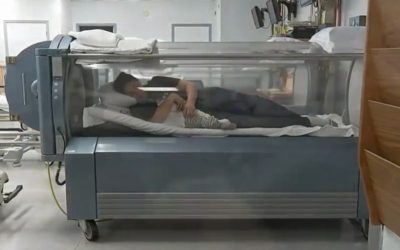Spinal anesthesia is the technique of choice in transurethral prostatectomy.However,one of
the common complications of spinal anesthesia is shivering which is even exaggerated in
patients undergoing transurethral prostatectomy.this high incidence is most probably caused
by sympathetic block and use of large amount of irrigation fluid during surgery.There are two
methods to reduce shivering.Previous studies showed that intrathecal fentanyl is an
appropriate method to reduce shivering.Intrathecal dexamethasone could reduce shivering by
regulating immune responses.
Clinical Trial – Inner and Middle Ear Effects of Hyperbaric Oxygen Thrapy
Audiological evaluation performed to patients on hyperbaric oxygen therapy to see its effects
on middle ear pressure
Inside the treatment that is helping a boy who nearly drowned
ABC13's Shelley Childers explains the treatment facility and the method used to help those like baby Dylan who nearly drowned. NEW ORLEANS, Louisiana (KTRK) -- Inside a small, indistinct building on the side of a busy street just south of New Orleans, small miracles...
Clinical Trial – The Effect of Hyperbaric OxygeN Therapy on brEast Cancer Patients With Late Radiation toxicitY – UMBRELLA HONEY Trial
The "Hyperbaric OxygeN therapy on brEast cancer patients with late radiation toxicity"
(HONEY) trial aims to evaluate the effectiveness of HBOT on late radiation toxicity in breast
cancer patients using the trial within cohorts (TwiCs) design.
Clinical Trial – Effect of Intravenous Magnesium on Post-spinal Fentanyl Induced Pruritus Incidence
Introduction: Adding opioids to local anesthetic solutions leads to enhanced anesthesia and
provide postoperative analgesia. Intrathecaly injected opioids have some side effects,
though. One of them is pruritus. Objective: We designed a randomized, double‐blinded,
placebo‐controlled study to evaluate prophylactic impact of continuous IV Magnesium 10mg/kg
over 30 minutes on intrathecal fentanyl‐induced pruritus start at the end of the operation.
Methods: ASA I‐II Patient’s candidate for orthopedic operations under spinal anesthesia
(10‐15mg hyperbaric bupivacaine and 25 µg fentanyl intrathecal) and will be divided randomly
into two groups:
Control group (Placebo group): bolus 100 ml nacl 0.9% at end of surgery Study group (Mg ++
group): (continuous IV Magnesium 10mg/kg in 100 ml Nacl0.9% over 30 minutes at end of
surgery).
Study outcome:
1. Hemodynamics: Systolic blood pressure, Mean arterial blood pressure, pulse rate, O2
saturation will be recorded in 5 min,10 min,30 min,60 min and every one hour till 6
hours after the operation.
2. Pruritus Patients were asked about existence (present=1,no=0), severity (mild=1,
modret=2, sever =3) and site of pruritus (Face(trigeminal) =1, neuroaxial(dermatome)=2),
1,2,4, and 6 hours after operation. Incidence of pruritus total group incidence %.
3. The incidence of PONV.
Is There an Association Between Hyperbaric Oxygen Therapy and Improved Outcome of Deep Chemical Peeling? A Randomized Pilot Clinical Study.
Abstract: Phenol chemical peeling (PCP) treatment is associated with prolonged recovery and sustained adverse events. Hyperbaric oxygen therapy (HBOT) is known to accelerate wound healing. The purpose of the current study was to evaluate the effect of HBOT on PCP...
Clinical Trial – Hyperbaric Oxygen Therapy After Stroke – PILOT
The goal of this pilot study is to establish more information about hyperbaric oxygen therapy
for this group of patients, and give us more information of how to initiate the best possible
main study. Can we find any indications that support the use of this therapy for patients
suffering from chronic disability after cerebral infarction? Can we improve physical and
cognitive function.
Clinical Trial – Treatment of Sudden Deafness With Prednisone+Hyperbaric Oxygen and Prednisone+Somatosensory Stimulation
To study the effective treatment of sudden deafness by giving prednisone, hyperbaric oxygen
and somatosensory stimulation to sudden deafness patients.
Clinical Trial – Effect of Intravenous Dexmedetomidine on Patient Discomfort in Laparoscopic Cholecystectomy Under Spinal Anesthesia.
Laparoscopic cholecystectomy (LC) has been routinely performed under general anesthesia
despite the several disadvantages of general anesthesia compared to regional anesthesia.
There are multiple reports that have been published regarding the feasibility of spinal
anesthesia for LC associated with many problems such as referred shoulder pain secondary to
intra-abdominal pneumoperitoneum; patient anxiety, pain, and discomfort; and inadequate
sedation.The aim of our study is to prospectively observe the feasibility of using
intravenous dexmedetomidine to abolish patient discomfort and shoulder pain, thus making the
patient more comfortable without causing excessive sedation and respiratory depression.
Clinical Trial – The Efficacy of Pain Control After Total Hip Replacement Between Ultrasound Guided Supra-inguinal Fascia Iliaca Block and Intrathecal Morphine
Total hip replacement is one of major orthopedic surgery which result in severe postoperative
pain especially at first 24 hours. Ultrasound guided regional anesthesia has become a part of
multimodal analgesia.Ultrasound guided supra-inguinal fascia iliaca block is a new technique
which can consistently cover femoral and lateral femoral cutaneous nerve. And with large
volume (40ml), it may cover obturator nerve. This technique already proved to be useful for
acute pain control in hip fracture or postoperative control in dynamic hip screw or nail
insertion operation. However, it has not been compared with intrathecal morphine for total
hip replacement yet.


